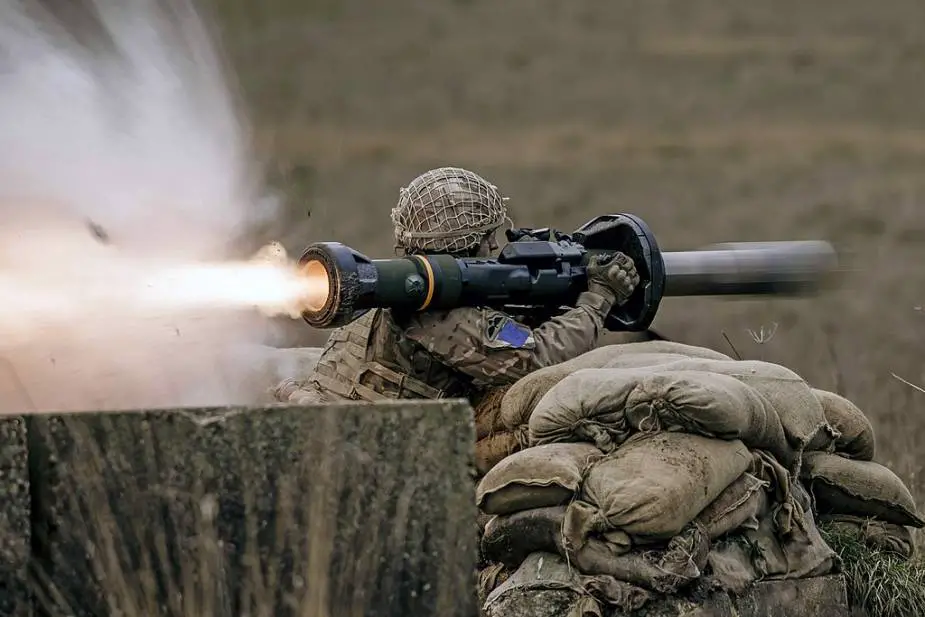Saab is targeting the figure of 400,000 for the production of its ground combat weapons and ammunition. “In the context of how we have doubled capacity from one year to the next at our Swedish sites…and by 2025 we will have doubled capacity again, then it will be possible to generate 400,000 units from our sites per year,” said Saab CEO Micael Johansson on February 10 while commenting on the financial results of his company.
Follow Army Recognition on Google News at this link

A member of the British 2nd Battalion, Parachute Regiment, firing an NLAW (Picture source: UK MoD)
Included in that 400,000 number are the company’s Carl Gustaf, AT4 and NLAW systems, all of which are man-portable weapons used against ground vehicles, as well as ammunition. "For the full year 2023, we expect organic sales growth to be around 15% and operating income growth to be higher than organic sales growth. We estimate operational cash flow to be positive for 2023", said Micael Johansson, President and CEO of Saab. Saab reported its overall order intake for 2022 amounted to SEK 63.1 billion ($6 billion USD), an increase of 45 percent from 2021. Nearly half of the annual 2022 order total was recorded in the fourth quarter, with an exceptional SEK 29.9 billion logged – an increase of 144 percent over the previous year.
“I would say that maybe in the last quarter, we started seeing some effects specifically from the tragic war in Ukraine,” said Johansson. “We can handle the requests that we see coming, including the orders that we received last year from the UK and Sweden,” added Johansson. “We have invested now in building up capacity to the extent that it will be sufficient for quite some time.”
Carl Gustaf 8.4 cm recoilless rifle
The Carl Gustaf 8.4 cm recoilless rifle is an 84 mm (3.3 in) caliber man-portable shoulder-fired recoilless rifle, initially developed by the Royal Swedish Army Materiel Administration during the second half of the 1940s as a close-range anti-tank and support weapon for infantry, which has seen great export success around the globe and is today a popular multi-purpose support weapon in use by many nations. The Carl Gustaf 84 mm recoilless rifle is a lightweight, low-cost weapon that uses a wide range of ammunition, which makes it extremely flexible and suitable for a wide variety of roles.
Development of the initial model started in 1946 as one of the many recoilless rifle designs of that era, based on the experience from the earlier Carl Gustaf 20 mm recoilless rifle and the success of man-portable rocket launchers during World War II, such as the Bazooka and Panzerschreck. Production of the initial model was handled by Carl Gustafs Stads Gevärsfaktori lead by Försvarets Fabriksverk (FFV) and the weapon received the designation 8,4 cm granatgevär m/48, (8,4 cm grg m/48 – "8,4 cm grenade rifle", model 1948) in Swedish service. FFV would continue to further develop the weapon for the international market, later being merged into Saab Bofors Dynamics which handles development and export today. While similar weapons have generally disappeared from service, the Carl Gustaf is still in production and remains in widespread use today, namely by the Ukrainian forces in their fight against the Russian invader.
AT4
The AT4 is a 84 mm (3.31 in) unguided, man-portable, disposable, shoulder-fired recoilless anti-tank weapon manufactured by Saab Bofors Dynamics (formerly: FFV Ordnance, later, Bofors Anti-Armour Systems). The AT4 is not considered a rocket launcher as the explosive warhead is not propelled by a rocket motor; similarly, it is not exactly a recoilless rifle, but rather a recoilless gun, as the launcher is smoothbore and not rifled. Saab has had considerable sales success with the AT4, making it one of the most common light anti-tank weapons in the world. The M136 AT4 is a variant used by the United States Army. The name AT4 was created for export purposes as the nickname "eighty-four" was already a common English nickname for the Carl Gustaf 8.4 cm recoilless rifle after its caliber.
The AT4 is intended to give infantry units a means to destroy or disable armored fighting vehicles and fortifications, although it is generally ineffective against more modern main battle tanks (MBTs), especially those with reactive armor, unless weaker sections of armor are exploited. The launcher and projectile are manufactured prepacked and issued as one unit of ammunition, with the launcher discarded after one use.
NLAW
The Saab Bofors Dynamics NLAW, also known as the MBT LAW or RB 57, is a fire-and-forget, lightweight shoulder-fired, and disposable (single-use) line of sight (LOS) missile system, designed for infantry use. The missile uses a soft-launch system and is guided by a predicted line of sight (PLOS). It can carry out an overfly top attack (OTA) on an armored vehicle, or a direct attack (DA) on structures and non-armored vehicles. The system was developed in Sweden by prime contractor Saab Bofors Dynamics, on behalf of the British and Swedish defense authorities who procured the system in a joint venture. It was mainly produced in the United Kingdom by Team MBT LAW UK, which included 14 subcontractors, most notably Thales Air Defence. Users of the weapon include Finland, Indonesia, Luxembourg, Malaysia, Sweden, Switzerland, Ukraine, and the United Kingdom.














